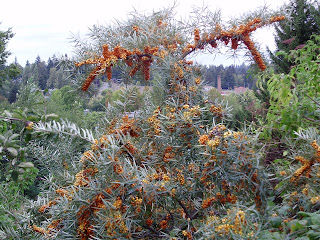Here are three of my favorite "unusual" edible shrubs and trees. All are available from www.raintreenursery.com.
First is the mulberry (Morus alba). Growing up in Indiana we played in thickets of mulberry, emerging with stained hands and full bellies! Illinois Everbearing is a self-fertile mulberry hardy to minus 30 degrees that performs great in the Puget Sound region. It will get 35' tall, but can be kept much smaller with pruning. There are also weeping and contorted varieties that fruit. The berries are 1 1/2" long, turn black when ripe, ripen over a long period (July-Sept) and are delicious. And you will have to learn how to share with the birds, as they adore the fruit as well. (Notice the robin in the first photo!)


Next is the Sea Buckthorn (Hippophae rhamnoides -- Say that 5 times fast!) This Russian native is a large shrub that gets 10'-12' tall and tolerates poor soil conditions. However it does need good drainage. Both ornamental (narrow, silver leaves) and edible (abundant yellow-orange fruit) this shrub makes a great feature plant or hedge. Requires a male and a female plant for pollination. In Europe and Asia the sour, flavorful fruit is prized as an anti-oxidant and a great source of vitamins C and E. Most often used in juices, jams, sauces and liqueurs.


And last, but not least, is the the aronia (Aronia melanocarpa). Rumored to be one of the most productive berries in the world (along with Sea Buckthorn and Goumi), this 5'-6' self-fertileshrub produces clusters of very tart purple-black berries. The tartness is a result of the high vitamin, mineral and anti-oxidant content of the fruit. Use in juices, smoothies, jams, syrups and wine.






